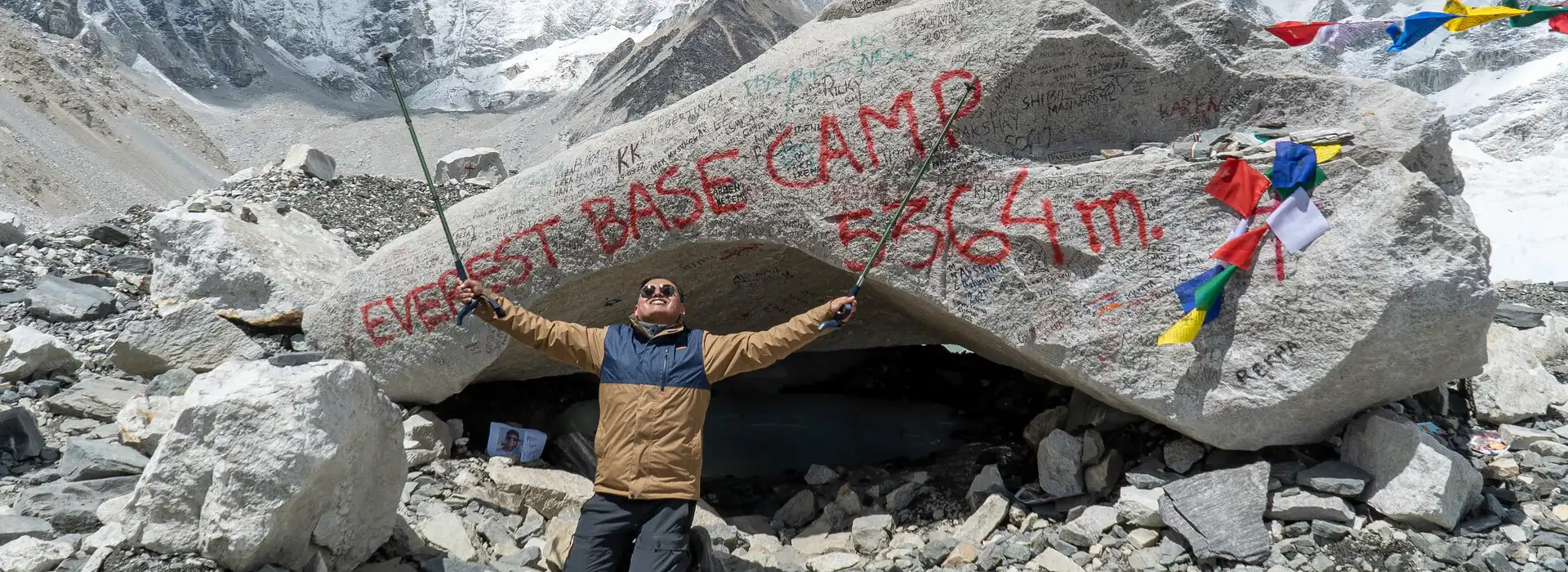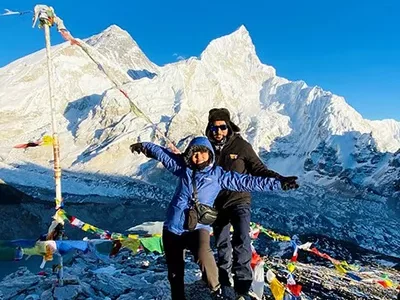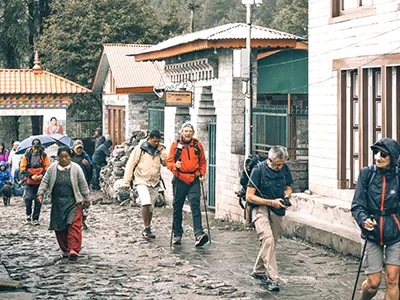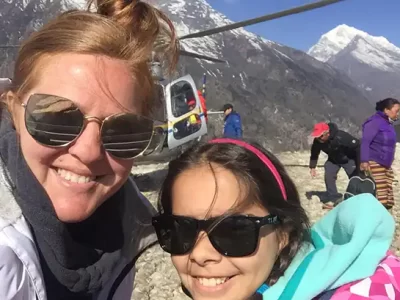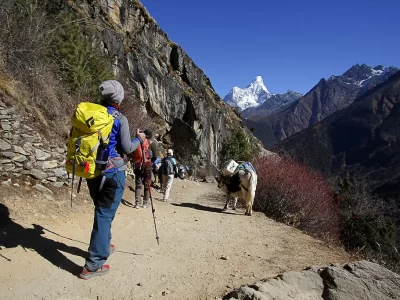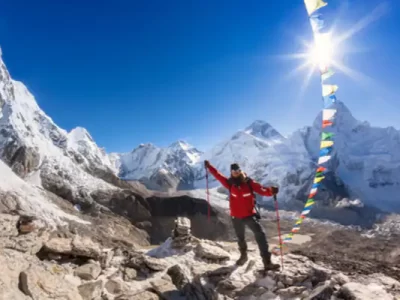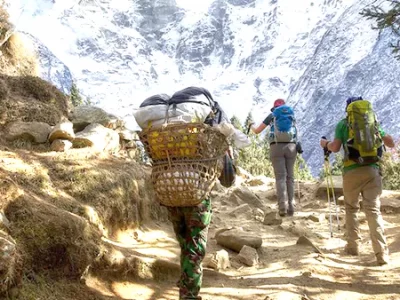Lots of people want to do the Everest Base Camp Trek. It has pretty views but is also hard. People need to get ready well before they go. The trek has great sights and is very tough. It makes people happy after they do it, but they have to work hard. People have to plan right so the trek is fun. Searching for How to train for Everest Base Camp is essential for many, as it underscores the need for a thorough physical and mental training program. This preparation is key to conquering this high-altitude adventure.
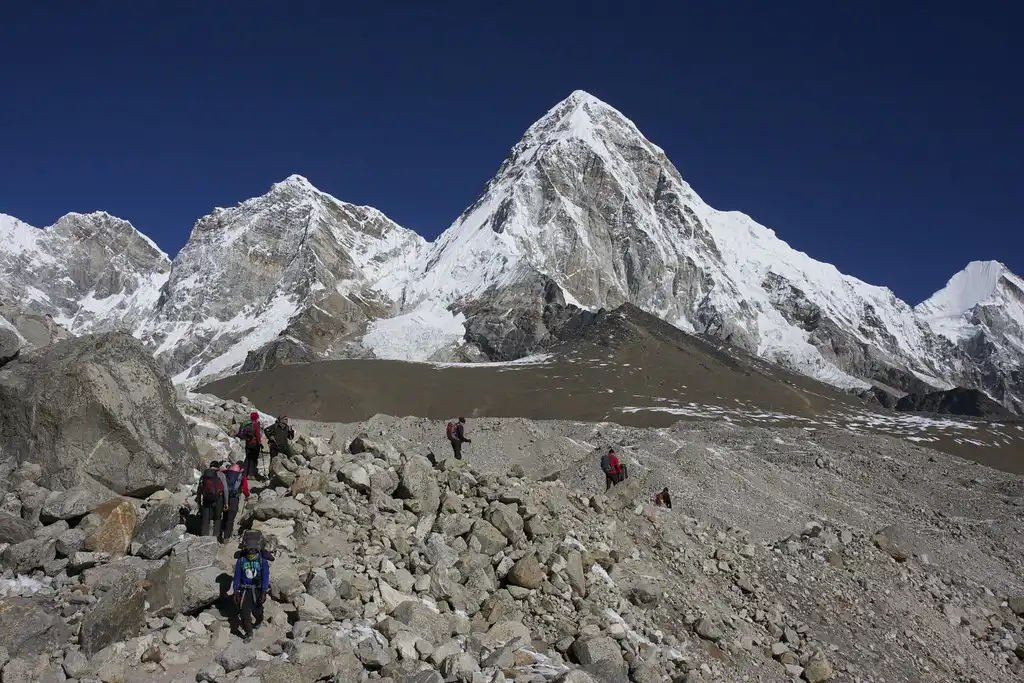
This trek leads to the renowned Everest Base Camp and extends to the more isolated Advanced Base Camp. Here, the air is even thinner, and the views are exceptionally dramatic. Understanding the complexities of this trek, including the Everest Base Camp Trek cost, is vital. Those interested should also learn about the requirements for the Advanced Base Camp Trek. This extended part of the trek requires more fitness and acclimatization.
Preparing for the trek is about more than physical readiness. Knowing how to plan the Everest Base Camp trek is crucial for setting realistic expectations. A tailored Everest Base Camp training program can significantly boost your endurance and strength. Moreover, tips for the Everest Base Camp trek from seasoned trekkers are incredibly helpful. They offer advice on everything from choosing the right equipment to managing your travel plans smoothly. With good groundwork, one can find a very rewarding experience while spending time at the Everest base camp while trekking.
Everest Base Camp Trek
Luxury Everest Base Camp Trek
Everest Base Camp Trek with Helicopter Return
Physical Training
Physical readiness is essential for successfully navigating the demanding Everest Base Camp Trek. This adventure requires both mental toughness and significant physical stamina, with a focus on cardiovascular and muscular strength.
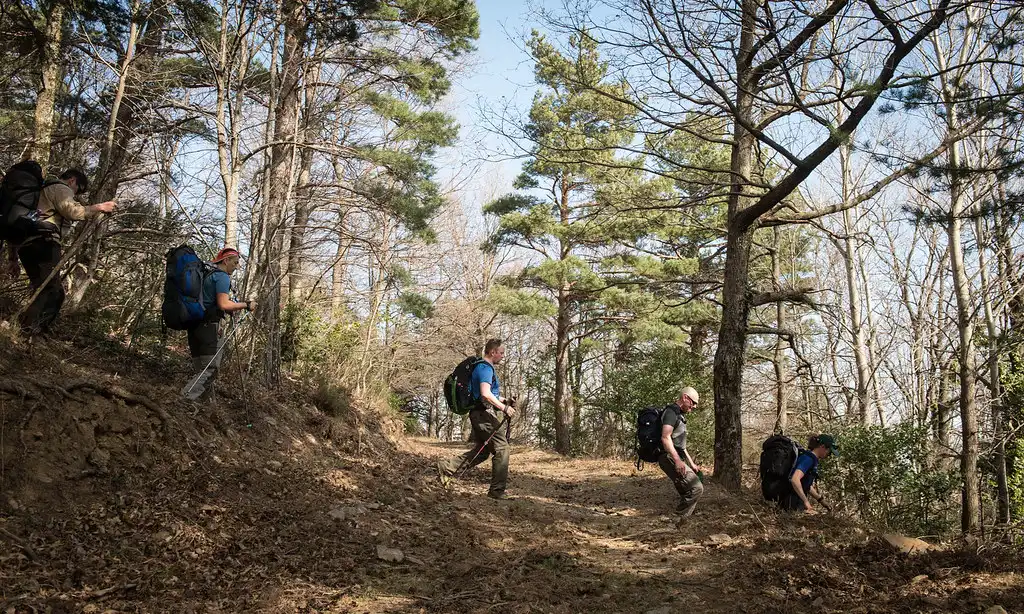
Optimal physical training involves exercises that boost your endurance, lung function, and muscle strength to withstand extended trekking days at high altitudes.
Cardiovascular Training
Recommended Exercises and Routines: Achieving cardiovascular fitness involves consistently keeping your heart rate high for long periods, just like on long trek days. Effective exercises include hiking on varied and inclined terrains, which closely replicates the challenges of Everest Base Camp. Running is also excellent for increasing lung capacity and endurance. Start with short distances and gradually increase them. Incorporate interval training to enhance your cardiovascular strength.
Cycling is great for strengthening the legs and building stamina, particularly on uphill routes, and prepares you for the trek’s prolonged efforts. Swimming, on the other hand, boosts overall fitness and lung capacity while being gentle on the joints, making it ideal for recovery days.
Training Schedule Suggestions: Engaging in a structured training regimen several months prior to your trek can significantly enhance your physical condition. Start 12-16 weeks before with light activities like walking and easy hikes, gradually increasing their length. Include 3-4 varied cardio workouts each week to work different muscle groups and boost overall fitness.
As the trek approaches, intensify your preparation. From 8-12 weeks out, add steeper climbs and a weighted backpack to your hikes. Extend and intensify running or cycling to build endurance. In the 4-8 weeks prior, focus on long, strenuous hikes. Reduce training intensity in the last four weeks to prevent injuries. Keep active with gentle runs, swims, or walks, focusing on stretching and flexibility.
Strength Training
Strength training is essential for tackling the demanding Everest Base Camp Trek. This trek involves lengthy hikes with a heavy backpack over challenging terrain. Training specific muscle groups improves performance and reduces injury risks. A focused regimen builds the endurance and stability needed for high-altitude trekking.
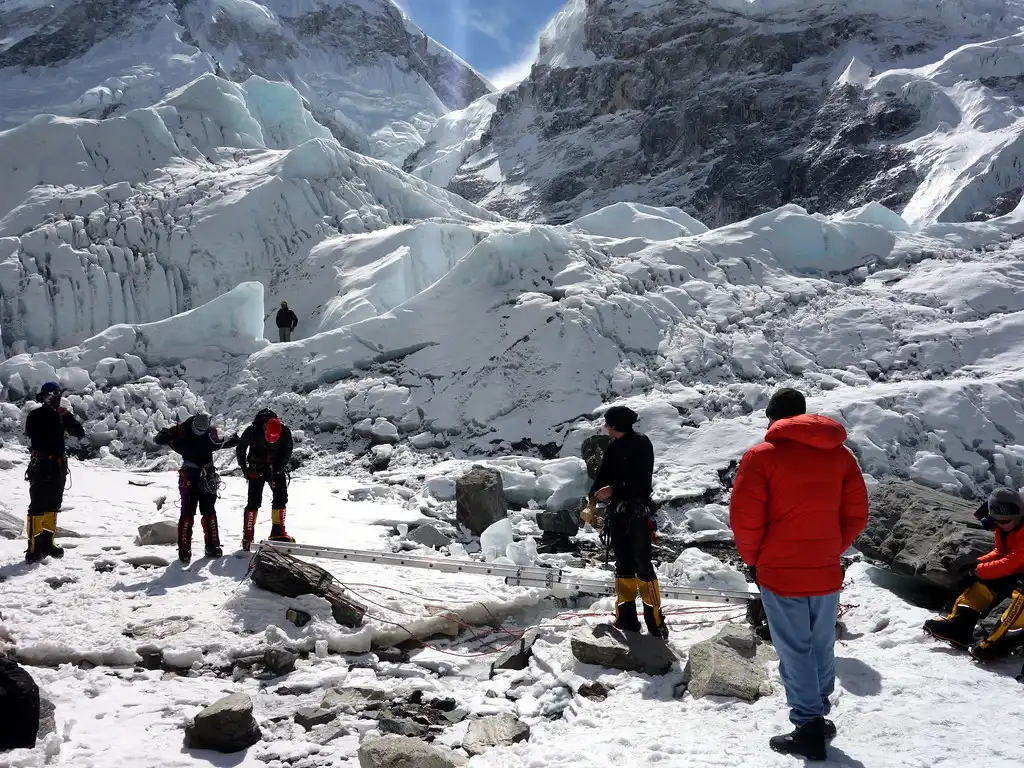
Key areas to strengthen include the legs, core, and upper body. Strong legs support climbing, descending, and carrying loads. A sturdy core stabilizes the body and eases the backpack’s weight, enhancing balance and endurance. The upper body is crucial for managing the backpack and using trekking poles, particularly on inclines. Strengthening these areas helps maintain posture and manage physical demands.
Effective exercises for these muscle groups include squats, lunges, planks, Russian twists, push-ups, pull-ups, and deadlifts. Squats and lunges build leg muscles, while planks and twists enhance core strength. Push-ups and pull-ups develop upper body strength, which is critical for backpack management. Deadlifts integrate leg, core, and back muscles, mimicking trek-related lifting and carrying. This comprehensive strength training ensures safe and enjoyable trekking experiences.
Mental Endurance
Mental endurance plays a crucial role, as does physical readiness, when gearing up for the Everest Base Camp Trek, challenging both endurance and mental strength. Trekkers encounter extreme environmental conditions and endure long, demanding days, emphasizing the importance of mental resilience in their training regimen.
A well-structured mental training program assists trekkers in managing expectations, maintaining positivity, coping with stress, and adapting to the high altitudes they will encounter.
Set Realistic Expectations
Fundamentally, mental preparation for the trek involves setting realistic expectations. It requires understanding the physical and mental challenges, such as the daily walking hours, the steep and uneven terrain, and the basic, often changing living conditions.
Familiarizing oneself with these aspects enables trekkers to prepare for the trek ahead mentally, reducing the likelihood of unexpected difficulties and emotional distress. This understanding helps build a mental framework accommodating the realities of trekking, mitigating potential disappointments, and preparing the mind for various scenarios.
Develop a Positive Mindset
To overcome the numerous obstacles on the trek, one must cultivate an optimistic outlook. Techniques for building mental resilience include:
- Visualization: Imagining oneself successfully navigating the trek and reaching the base camp enhances motivation and emotional strength.
- Affirmations: Regularly affirming one’s strength and preparedness through positive self-talk reinforces a trekker’s belief in their ability to complete the trek, diminishing doubts and bolstering mental toughness.
Learn Relaxation Techniques
Effectively managing stress and anxiety is critical, emphasizing the importance of learning relaxation techniques. Techniques promoting relaxation and mental calmness include:
- Deep Breathing: To control the physiological signs of stress and anxiety, concentrate on taking deep, steady breaths. This practice promotes a calm mind.
- Meditation: Regular meditation aids in maintaining focus and mental clarity, reducing overall stress levels.
- Progressive Muscle Relaxation: Physical and psychological tension can be efficiently reduced by sequentially tensing and relaxing different muscle groups.
Appropriate Acclimatization Plan
Integral to the mental training process is an appropriate acclimatization plan, emphasizing gradual adaptation to the high-altitude environment of the Everest Base Camp. Understanding the importance of acclimatization can alleviate anxiety related to altitude sickness and physical performance. Strategies should include scheduled rest days and shorter treks at increased elevations to allow the body—and mind—to adapt to reduced oxygen levels progressively.
Everest Base Camp Short Trek
Jiri to Everest Base Camp Trek
Everest View Trek
Gear Up for Everest Base Camp Comfort
The right gear makes your Everest Base Camp trek amazing. Pack for ever-changing weather at high altitudes. This list keeps you comfy and safe.
Clothes: Layer Up
Pack clothes that keep you dry. Get thermals made of wool or fake wool.
Bring two sets of thermals to switch if one gets sweaty.
Grab a fleece coat or down coat for warm breaks and mornings and nights.
Wear a rain and windproof jacket and pants. Look for Gore-Tex or like fabrics.
Pack a few fast-drying hiking shirt for hot days.
Get pants with legs that zip off for changing weather. Pick water-blocking or fast-drying stuff.
Wear a warm wool or fleece hat at high-up places.
Protect your face from the sun with a big brim hat.
Pack thin gloves for warmth and rainproof gloves for wet and snow.
Trekking Poles: Walk Strong
For the Everest Base Camp trek, we highly recommend using trekking poles as they provide numerous benefits. Trekking poles enhance stability and balance on uneven terrain, reducing the risk of slips or falls.

They distribute weight across the upper body, alleviating pressure on knees and joints, thereby making the trek less taxing on your body. Additionally, trekking poles assist in maintaining a steady pace and rhythm while ascending, contributing to a more efficient and comfortable trekking experience overall.
Choose the Right Trekking Poles
When you pick poles for trekking, think about this. Aluminum poles are light and cheap. Carbon fiber poles are lighter but cost more money. What you like and how much money you have should help you choose.
You should pick poles that you can change to fit your height when your arm bends at ninety degrees while holding the pole. Make is sure they lock well so the length is right for you when you trek.
Stay Clean on the Trail
Remember to pack hand sanitizer! It’s essential to clean your hands thoroughly before eating and after using the restroom, especially since facilities on the trek can be limited. Wet wipes are handy for a quick freshen up or cleaning dirty hands and face.
Use soap and shampoo that break down naturally to reduce your impact on the environment. Also, pack toilet paper just in case some teahouses don’t provide it. Finally, include a quick-drying microfiber towel for a refreshing wash after the trek when it dries rapidly.
Moisturize Your Skin
The air in the mountains is dry, and the sun is harsh. These can hurt your skin. So pack good sunscreen with SPF 30 or higher. Please put it on your face and other skin that is out. Also, take a lip balm with high SPF. It will keep your lips from getting too dry and cracked.
Be Prepared for Minor Injuries
Put some basic stuff in a small bag for cuts and pains. In the bag, have small pads for blisters. Use wipes to clean cuts. Take pills for headaches, sore muscles, and fevers. Also, bring bandages and cream for cuts. Make sure you have your needed drugs. Take this small bag on trips or when outside.
Nutrition and Hydration
A healthy diet and adequate fluids are essential for finishing the Everest Base Camp Trek. Trekkers must focus on their dietary and hydration strategies due to the intense physical exertion and high-altitude conditions. A well-planned nutrition regimen helps maintain energy levels and overall health, while effective hydration prevents altitude sickness and sustains physical performance under strenuous conditions.
Nutrition
As you prepare for the Everest Base Camp Trek, prioritizing a diet that enhances sustained energy and muscle recovery is essential. Incorporate complex carbohydrates from whole grains and legumes for lasting energy, which is crucial during lengthy treks. Proteins must also play a central role in your diet, aiding muscle repair and recovery through various sources such as lean meats, dairy, and plant-based foods like beans and lentils.
Include healthy fats from nuts, seeds, avocados, and olive oil to sustain energy levels, which is particularly important at higher altitudes. Moreover, consuming a diet rich in micronutrients—iron, calcium, and B vitamins from a variety of fruits and vegetables—supports energy metabolism and oxygen transport. Such a balanced, nutrient-rich diet ensures trekkers maintain the stamina and health necessary to handle the demands of the trek.
Hydration
Hydration significantly influences the Everest Base Camp Trek, especially since dehydration can amplify the symptoms of altitude sickness. You must consume at least 3-4 liters of water daily, even in a cold climate that might not prompt thirst. Integrating electrolytes into your hydration strategy is crucial for maintaining fluid balance in your body, and using electrolyte tablets or solutions proves especially helpful during long trekking days.
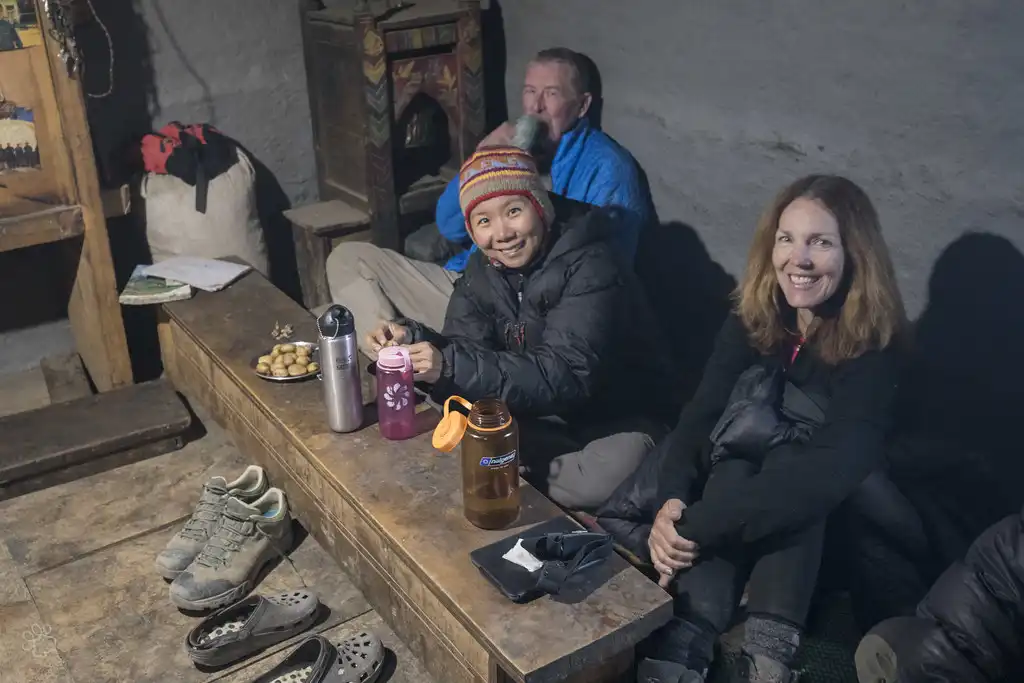
It’s important to avoid diuretics such as caffeine and alcohol, as they can lead to increased dehydration. Always carry a reusable water bottle and secure access to safe drinking water with purification tablets or a portable water filter. Actively planning where and how often to refill your water bottle throughout the trek is essential for maintaining proper hydration, which not only helps prevent dehydration but also ensures optimal physical performance in the challenging conditions of high altitude.
Other Preparations for Everest Base Camp Trek
Preparing for the Everest Base Camp Trek extends beyond physical and mental training; it involves key logistical planning to ensure a smooth and secure trek.
Travel Insurance
Securing travel insurance is essential for any trekking, particularly one as demanding as the Everest Base Camp Trek. A good policy should cover high-altitude trekking and provide for medical emergencies, evacuation (including helicopter rescue), trip cancellations, and loss of baggage or personal items. Such coverage helps manage unexpected medical expenses and losses, allowing trekkers to concentrate on enjoying their adventure without financial worries.
Booking Your Flights Early
Early flight bookings for the Everest Base Camp Trek bring numerous benefits. Making reservations early often results in lower fares and better seat choices, especially during the trek’s peak seasons in spring and fall. Early bookings also provide more options for selecting the most convenient flight schedules and connections, making travel to and from Nepal less stressful.
Two Days Buffer Day
Incorporating at least two buffer days into your itinerary is a wise decision. These additional days help manage any unexpected delays caused by weather, health issues, or other unforeseen challenges during the trek. Such flexibility in the schedule can transform a potentially rushed and stressful trek into a more relaxed and rewarding experience.
Get in contact with an agent or trekking specialist in Nepal
They possess far more knowledge than occasional trekkers or those who rely solely on internet resources. Each client’s trek enriches their expertise, backed by their own extensive trekking experiences. Grant them the authority to arrange the following for you:
- All accommodations and transfers
- All meals
- A detailed itinerary
- A licensed guide for the trek
- Necessary trekking permits and a TIMS Card (Trekker Information Management System)
- Domestic flights between Kathmandu and Lukla
- Porters to carry your baggage
Trekking Tips
- Acclimatize Properly: Allocate days specifically for acclimatization to prevent altitude sickness.
- Stay Hydrated: Drink between 3-4 liters of water daily to prevent dehydration.
- Dress in Layers: Quick weather changes demand adaptable, layered clothing.
- Use Quality Gear: Invest in sturdy hiking boots, a reliable sleeping bag, and trekking poles.
- Eat High-Calorie Foods: Consume a diet rich in carbohydrates and proteins to maintain energy.
- Start Early: Hit the trail early each morning to make the most of the favorable weather conditions.
- Respect Local Culture: Always engage with local customs respectfully and seek permission before taking photos.
- Maintain a Positive Attitude: Stay adaptable and upbeat, no matter the obstacles.
- Ensure Adequate Insurance: Verify that your travel insurance includes coverage for high-altitude trekking and emergencies.
- Consider Hiring a Guide or Porter: Enhance your trekking experience and lighten your load by hiring local guides and porters.
- Carry Enough Cash: Since ATMs are scarce, bring ample cash in small denominations.
- Pack Essential Items: Remember to pack sunscreen, lip balm, sunglasses, a hat, a first-aid kit, and a headlamp.
Conclusion
Physical and mental preparation, proper nutrition and hydration, and strategic logistic preparation are required to plan to trek to the Everest Base Camp. Could you make sure to acclimatize properly, maintain hydration, invest in quality gear, and show respect for the local culture?
With thorough preparations and a positive outlook, you can confidently overcome the challenges of this extraordinary adventure. Embrace each moment of your trek with enthusiasm and confidence as you are about to undertake one of the world’s most iconic treks.
